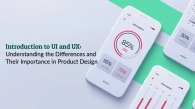Strong Marketing is imperative today. Marketing is critical to build a strong brand equity and market traction. Digital Marketing is the most effective way to market your product or service and it is the most effective way to reach your target audien ...
Introduction to UI and UX: Understanding the Differences and Their Importance in Product Design
In today's digital landscape, the success of a product largely depends on its user experience. Although UI and UX are often used interchangeably, they have distinct roles in the design and development process. To create products that meet the needs a ...
Navigating the UI/UX Design Process: A Step-by-Step Journey
What is User Experience? User experience (UX) refers to the value and satisfaction users derive from interacting with a product. It focuses on improving usability, accessibility, and pleasure in the user's interaction. By understanding user needs and ...
Creating Consistency and Delight: The Power of UX Design Systems
What is a UX Design System? A UX design system is a collection of reusable components, patterns, and guidelines that help designers and developers create consistent and user-friendly experiences across a product or platform. Design systems can save t ...




